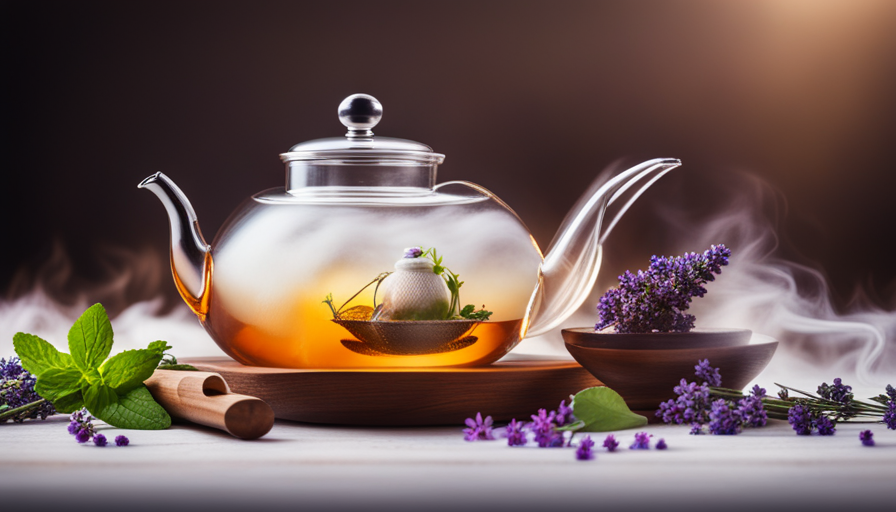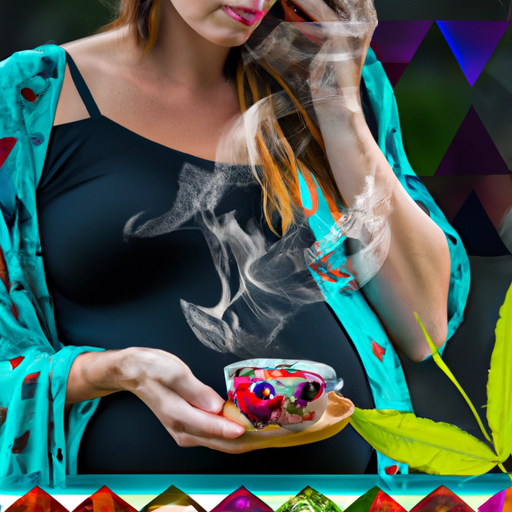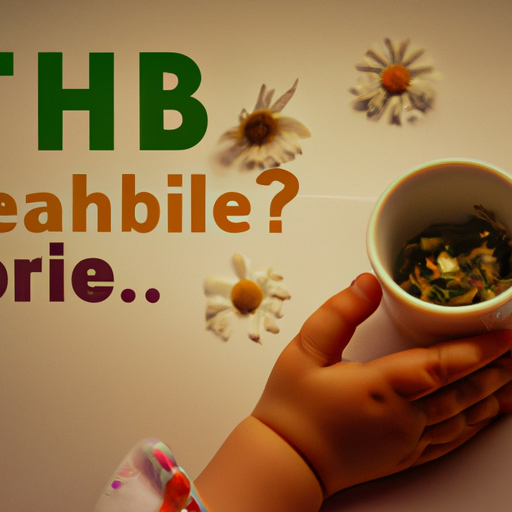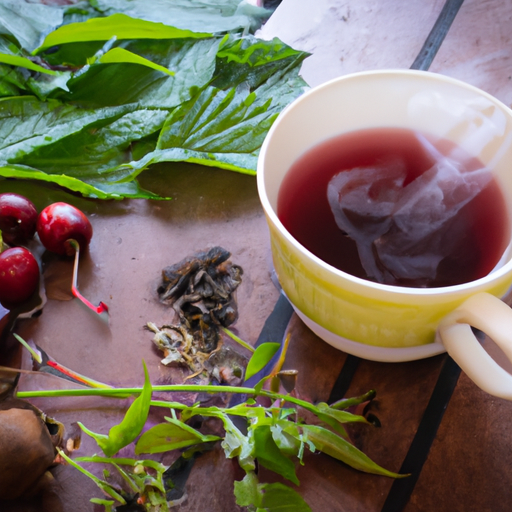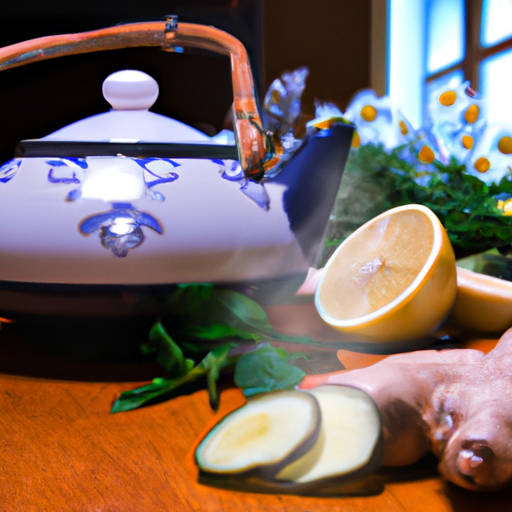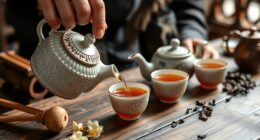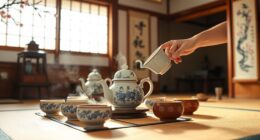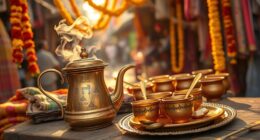Were you aware that the taste and scent of your herbal tea can be significantly impacted by the brewing temperature? Different types of herbal teas actually require specific temperatures for the best brewing results.
According to a recent study, the temperature can impact the release of certain compounds in the tea leaves, resulting in a distinct taste profile. So, if you want to enjoy the full potential of your favorite herbal teas, it’s important to brew them at the right temperature.
In this article, I will guide you through the ideal brewing temperatures for various popular herbal teas, such as chamomile, peppermint, green tea, hibiscus, ginger, rooibos, and lemon balm. By following these guidelines, you can ensure that each cup of herbal tea you brew is infused with the perfect balance of flavors and aromas.
So, let’s dive in and discover the art of brewing herbal tea at the ideal temperature.
Key Takeaways
- Each type of herbal tea requires a specific brewing temperature for optimal flavor and aroma.
- Chamomile tea should be brewed at 200°F for full extraction of flavors and relaxation benefits.
- Peppermint tea should be brewed at 212°F for invigorating flavors and digestive benefits.
- Experimenting with different temperatures and steeping times can result in varying flavor profiles for personalized tea experiences.
Understanding the Basics of Herbal Tea Brewing
Now, let’s dive into the art of brewing herbal tea and discover how you can create a warm and soothing cup of goodness.
Herbal tea has been enjoyed for centuries for its numerous health benefits. Not only does it provide a comforting and relaxing experience, but it also offers various healing properties depending on the herbs used.
When brewing herbal tea, it’s important to choose the right herbs for your specific health concerns. For example, chamomile tea is known for its calming properties and can aid in treating insomnia and anxiety.
To brew chamomile tea, it’s best to use water heated to around 200°F. This temperature allows the flavors and medicinal properties of the chamomile to be extracted fully, resulting in a delightful cup of tea that promotes relaxation and sleep.
So, if you’re looking to unwind and enjoy a peaceful evening, consider brewing a cup of chamomile tea at 200°F.
Chamomile Tea: Best Brewed at 200°F
For the perfect cup of chamomile tea, you’ll want to steep it at a soothingly warm 200°F. This temperature is ideal for extracting the full flavor and benefits from the chamomile flowers. Steeping chamomile tea at a lower temperature can result in a weaker flavor, while steeping it at a higher temperature can make the tea taste bitter.
When brewing chamomile tea at 200°F, you can expect a cup of tea that’s delicately floral and soothing. The warm water helps release the essential oils and compounds in the chamomile flowers, giving you a cup of tea that’s calming and relaxing.
To make the most out of your chamomile tea experience, here are two tips to consider:
- Use fresh, high-quality chamomile flowers for the best flavor and aroma.
- Steep the tea for at least 5 minutes to ensure maximum extraction of the chamomile’s beneficial compounds.
By following these tips and brewing your chamomile tea at 200°F, you’ll be able to enjoy a cup of tea that’s both flavorful and therapeutic.
Now, let’s move on to peppermint tea. The optimal brewing temperature for peppermint tea is 212°F, which is the boiling point of water.
Peppermint Tea: Optimal Temperature is 212°F
Get ready to savor the invigorating flavors of peppermint tea by brewing it at the optimal temperature of 212°F! Peppermint tea is not only delicious but also offers numerous benefits and uses. It is known for its calming properties and can help alleviate digestive issues, headaches, and even cold symptoms. To brew peppermint tea, there are different methods you can try. One popular method is to use fresh peppermint leaves and steep them in boiling water for about 5-10 minutes. Another option is to use peppermint tea bags and steep them in hot water for the same amount of time. Whichever method you choose, make sure the water temperature is 212°F to extract the maximum flavor and benefits from the peppermint leaves.
To help you remember the optimal temperature for brewing peppermint tea, take a look at the table below:
| Brewing Method | Water Temperature |
|---|---|
| Fresh Leaves | 212°F |
| Tea Bags | 212°F |
Now that you know how to brew peppermint tea at the perfect temperature, let’s move on to the next section about green tea. Green tea should be steeped at 175°F for maximum flavor.
Green Tea: Steep at 175°F for Maximum Flavor
To truly experience the exquisite flavors and delicate aroma of green tea, you should steep it at a temperature of 175°F, allowing its essence to unfold and transport you to a serene and tranquil state of mind.
Green tea, known for its numerous health benefits, requires a lower brewing temperature compared to other types of tea. Here are some green tea brewing tips to help you achieve maximum flavor:
-
Use filtered water: The quality of water can greatly affect the taste of your tea. Using filtered water ensures a clean and pure flavor.
-
Preheat your teapot: Before adding the tea leaves, preheating your teapot with hot water helps maintain the desired temperature throughout the steeping process.
-
Steep for the right amount of time: To avoid any bitterness, steep green tea for about 2-3 minutes. This allows the flavors to fully develop without becoming overpowering.
Brewing herbal tea at the right temperature not only enhances the taste but also maximizes its health benefits.
Now, let’s move on to hibiscus tea, which offers a tangy taste when brewed at 208°F.
Hibiscus Tea: Brew at 208°F for a Tangy Taste
Brewing hibiscus tea at a slightly higher temperature reveals its tangy and vibrant flavors. When it comes to brewing techniques, it’s important to note that hibiscus tea requires a higher water temperature compared to other herbal teas.
To fully extract its rich flavors, steep hibiscus tea at 208°F. This higher temperature allows the tart and citrusy notes of the hibiscus petals to shine through, creating a refreshing and tangy taste.
Not only does hibiscus tea offer a delightful flavor profile, but it also boasts numerous health benefits. Rich in antioxidants, this vibrant red tea can help lower blood pressure and cholesterol levels. It is also known for its potential to support liver health and promote weight loss.
Incorporating hibiscus tea into your daily routine can be a great way to enjoy a delicious beverage while reaping these health benefits.
Moving on to the next section about lavender tea, infusing it at 195°F brings out its relaxing aroma. Lavender tea is well-known for its soothing properties and delicate floral scent.
Lavender Tea: Infuse at 195°F for a Relaxing Aroma
Lavender tea, with its delicate floral scent and soothing properties, can be infused at 195°F to bring out a relaxing aroma that will transport you to a serene state of mind. Known for its calming effects, lavender tea is the perfect choice when you need to unwind and de-stress.
To prepare this tea, start by boiling fresh water and letting it cool for a few minutes until it reaches the desired temperature of 195°F. Then, add a teaspoon of dried lavender flowers to a cup and pour the hot water over them. Allow the tea to steep for about 5 minutes to achieve the full flavor and relaxing benefits. The longer you steep, the stronger the lavender aroma will be.
Once the infusion is complete, strain the tea and enjoy the calming fragrance as you take your first sip.
Transitioning to the next section about ginger tea, best brewed at 212°F for a spicy flavor, it’s important to note that each herbal tea has its own optimal brewing temperature to extract the maximum benefits and flavors.
Ginger Tea: Best Brewed at 212°F for Spicy Flavor
Ginger tea, when brewed at 212°F, offers a spicy flavor that is invigorating and satisfying. Did you know that ginger has been used for centuries in traditional medicine for its anti-inflammatory properties? It’s no wonder that ginger tea is a popular choice for those seeking a flavorful and healthful beverage.
When it comes to brewing herbal tea, the temperature plays a crucial role in extracting the desired flavors and benefits. The best brewing time for ginger tea is at 212°F, which allows the spicy notes to fully develop and infuse into the water. This high temperature also helps to release the natural oils and compounds in ginger, resulting in a more potent and flavorful brew.
Additionally, brewing herbal tea at specific temperatures ensures that you’re getting the most out of the ingredients, as different compounds are released at different temperatures.
Now, let’s move on to another delightful herbal tea: rooibos tea. Steeped at 212°F, this tea offers a rich and nutty flavor that is sure to please.
Rooibos Tea: Steep at 212°F for a Rich and Nutty Brew
To fully savor the rich and nutty flavor of rooibos tea, you’ll want to steep it at a temperature of 212°F. This is the perfect temperature to extract the full range of flavors and aroma from the dried leaves.
Here are some brewing tips to help you make the most of your rooibos tea:
- Use freshly boiled water: Boiling water will help to release the flavors and essential oils from the tea leaves, resulting in a more flavorful brew.
- Steep for at least 5 minutes: Rooibos tea requires a longer steeping time to fully develop its rich flavor profile. Give it a good 5 minutes to ensure a robust and delicious cup.
- Add a touch of sweetness: Rooibos tea has a naturally sweet taste, but adding a hint of honey or a slice of lemon can enhance its flavors even more.
In addition to its delicious taste, rooibos tea also offers many health benefits. It is rich in antioxidants that can help boost your immune system and protect against cell damage. Rooibos tea is also caffeine-free, making it a great choice for those looking to reduce their caffeine intake.
Moving on to lemon balm tea, the optimal temperature for brewing is 200°F.
Lemon Balm Tea: Optimal Temperature is 200°F
For the perfect cup of lemon balm tea, you’ll want to steep it at an optimal temperature of 200°F, which ensures a delightful balance of flavors and aromas. Did you know that lemon balm has been used for centuries to promote calmness and reduce anxiety? This herbal tea is not only soothing but also refreshing, making it a popular choice for tea enthusiasts. When brewed at 200°F, the lemon balm leaves release their natural oils and flavors, resulting in a bright and citrusy infusion.
To give you a better understanding of the brewing process, here is a table showcasing the optimal temperature for brewing lemon balm tea:
| Tea Type | Brewing Temperature |
|---|---|
| Lemon Balm Tea | 200°F |
Experimenting with different temperatures and steeping times can lead to varying flavor profiles. So, if you prefer a stronger lemon flavor, you can try increasing the temperature slightly or steeping it for a longer duration. However, be cautious not to exceed the recommended temperature, as it may result in a bitter taste. Now, let’s dive into the exciting world of experimenting with different temperatures and steeping times to discover your perfect cup of lemon balm tea.
Experimenting with Different Temperatures and Steeping Times
Explore the fascinating realm of flavor exploration by experimenting with a range of temperatures and steeping times, allowing you to uncover the hidden nuances and complexities within your cup of lemon balm infusion. When it comes to brewing herbal tea, temperature plays a crucial role in extracting the flavors and aromas from the leaves. By varying the temperature and steeping time, you can discover different flavor profiles and create a truly personalized tea experience.
Start by brewing your lemon balm tea at a lower temperature, around 160°F, and steep it for a shorter time, such as 3-4 minutes. This gentle brewing process will result in a lighter and more delicate flavor. You may notice subtle hints of citrus and floral notes that are refreshing and soothing to the palate.
If you prefer a stronger and more robust flavor, try increasing the temperature to around 180°F and steeping for a longer time, such as 5-6 minutes. This bolder infusion will bring out the herbaceous and slightly minty flavors of the lemon balm.
Experimenting with different temperatures and steeping times allows you to unlock a whole range of flavor possibilities. Keep in mind that personal taste preferences may vary, so don’t be afraid to adjust the brewing parameters to suit your own palate. Enjoy the journey of discovering the intricate flavor profiles that lie within your cup of lemon balm tea.
Frequently Asked Questions
How long should I steep herbal tea for maximum flavor?
To achieve the utmost flavor extraction from herbal tea, steeping time is crucial. The longer you let the tea leaves mingle with the hot water, the more intense and robust the flavor profile becomes. It’s like a symphony of flavors dancing on your taste buds, intensifying with each passing second.
So, for maximum flavor, I suggest steeping herbal tea for a generous amount of time, allowing the flavors to fully develop and enchant your senses.
Can I use boiling water to brew herbal tea?
Using lower temperatures for brewing herbal tea can be beneficial. Boiling water may be too hot for delicate herbal teas, as it can result in a bitter or overpowering taste. By using different water temperatures, you can enhance the flavor and aroma of your herbal tea. Steeping herbal tea at a slightly lower temperature, around 190°F (88°C), allows the natural flavors to gently infuse into the water, creating a more enjoyable and balanced cup of tea.
Are there any herbal teas that should not be brewed at high temperatures?
Brewing herbal tea at high temperatures may pose potential health risks. Some herbal teas, such as chamomile and hibiscus, can become bitter and lose their delicate flavors when brewed with boiling water. It’s important to follow the recommended brewing temperatures for each specific herbal tea to ensure optimal taste and avoid any negative effects.
Additionally, properly storing herbal tea in an airtight container away from light and moisture helps maintain its freshness and potency.
Can I adjust the brewing temperature based on personal preference?
Yes, you can definitely adjust the brewing temperature of herbal tea based on your personal preference. The brewing temperature can affect the flavor and strength of the tea. For a milder taste, you can try using a lower temperature, while a higher temperature may result in a stronger brew. Experimenting with different temperatures will allow you to find the perfect balance that suits your taste buds.
What are the potential health benefits of herbal tea?
Potential health benefits of herbal tea include improved digestion, reduced inflammation, boosted immune system, and relaxation.
Popular herbal teas like chamomile, peppermint, and ginger have been used for centuries to promote wellness and alleviate various ailments.
Chamomile tea is known for its calming effects, while peppermint tea aids digestion.
Ginger tea has anti-inflammatory properties.
Incorporating these herbal teas into your daily routine can provide a natural and delicious way to support your overall health and well-being.
Conclusion
After exploring the various temperatures for brewing herbal tea, I’ve discovered that each type of tea has its own optimal temperature for maximum flavor. By brewing chamomile tea at 200°F, peppermint tea at 212°F, green tea at 175°F, hibiscus tea at 208°F, ginger tea at 212°F, rooibos tea at 212°F, and lemon balm tea at 200°F, you can ensure a delicious and satisfying cup every time.
So go ahead, experiment with different temperatures and steeping times to find your perfect brew and enjoy the rich and diverse world of herbal teas.

